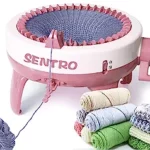Ah, the joy of knitting with multiple colors – you decided to tackle a striped scarf, envisioning a cozy masterpiece to keep you warm in style. Full of enthusiasm, you cast on and begin knitting, feeling like a knitting wizard with your array of colorful yarns.
But wait, as you reach the end of the first stripe, a moment of panic sets in. How on earth do you switch colors without creating a tangled mess? You fumble around, attempting to tie knots and hoping for the best. Alas, the result is far from the neat stripes you imagined – it's more like a knitted rainbow gone wild.
In a desperate attempt to salvage your scarf, you ask a fellow knitter for advice. They kindly show you the art of color switching, and a lightbulb moment ensues. As you unravel your chaotic creation, you can't help but laugh at your colorful mishap.
Now armed with the knowledge of the proper color-switching technique, you confidently start anew. With each color transition, you weave the yarn like a pro, creating flawless stripes that make your heart sing with pride. You rock that striped scarf, impressing everyone with your knitting prowess, and secretly thanking the knitting gods for the art of color switching. Happy knitting, with no more rainbow tangles in sight!
How to Switch Colors in Knitting: Adding a Splash of Creativity to Your Projects
Switching colors in knitting opens up a world of creative possibilities, allowing you to create vibrant patterns, stripes, and colorwork designs. Whether you're knitting a cozy scarf, a stylish sweater, or a cute baby blanket, mastering the art of color switching is a valuable skill that every knitter should have in their repertoire. In this comprehensive guide, we'll explore various methods for switching colors in knitting, step-by-step instructions, helpful tips, and inspiration for incorporating color into your projects.
The Importance of Knowing How to Switch Colors in Knitting
Understanding how to switch colors in knitting is essential for various reasons:
- Creating Colorful Designs: Adding multiple colors to your knitting projects can bring depth and dimension to your designs, making them visually striking and unique.
- Stripes and Patterns: Switching colors allows you to create beautiful stripes and intricate colorwork patterns, elevating the appearance of your knitted items.
- Personalization: Color choice is a powerful tool for personalizing your knitting projects, allowing you to express your style and creativity.
Preparing to Switch Colors
Before you dive into color switching, there are a few preparatory steps to consider:
- Choose Yarn Colors: Select yarn colors that complement each other and suit the project you're working on. Experiment with color combinations to find what works best.
- Yarn Management: To avoid a tangled mess, make sure your yarn is well-organized. Consider using yarn bobbins, separate yarn balls, or pre-winding small balls of each color.
- Proper Tension: Maintain consistent tension throughout your knitting, especially during color switches, to ensure even stitches.
Method 1: The Weaving Method
The weaving method is a straightforward technique for switching colors, ideal for stripes and color blocks. Follow these steps:
Step 1: Knit up to the point where you want to switch colors.
Step 2: Drop the old color, leaving a tail of yarn long enough to weave in later.
Step 3: Pick up the new color, leaving a tail as well.
Step 4: Hold the old color and new color together for the first few stitches. This helps secure the new color.
Step 5: Weave in the ends as you continue knitting. Weave the tails over the stitches on the wrong side of the work to prevent them from showing on the right side.
Method 2: Intarsia Colorwork
Intarsia is a technique used for color blocks and large, distinct patterns. It involves using separate balls of yarn for each color section, rather than carrying the unused colors across the back of the work. Follow these steps:
Step 1: Knit up to the point where you want to switch colors.
Step 2: Drop the old color and join the new color by knitting the first stitch with the new yarn.
Step 3: Leave a tail of yarn for both the old and new colors, making sure they are long enough to weave in later.
Step 4: Knit across the section with the new color.
Step 5: When you reach the end of the color section, drop the new color, and pick up the old color by knitting the first stitch with it.
Step 6: Knit across the section with the old color.
Step 7: Repeat steps 2 to 6 for each color section, making sure to twist the yarns at the color change to avoid holes.
Step 8: Weave in the ends on the wrong side of the work.
Method 3: Fair Isle or Stranded Colorwork
Fair Isle, also known as stranded colorwork, is a technique that involves carrying two or more colors across the back of the work. This method is commonly used in traditional Nordic designs and intricate patterns. Follow these steps:
Step 1: Knit up to the point where you want to switch colors.
Step 2: Drop the old color and join the new color by knitting the first stitch with the new yarn.
Step 3: Leave a tail of yarn for both the old and new colors, making sure they are long enough to weave in later.
Step 4: Hold the unused color(s) at the back of the work and knit with the new color. Make sure not to pull the carried yarns too tightly, as it can cause puckering.
Step 5: When you need to switch colors, drop the old color and pick up the new color. Carry the unused color(s) across the back of the work.
Step 6: Repeat steps 2 to 5 for each color change, twisting the yarns at the color change to avoid holes.
Step 7: Weave in the ends on the wrong side of the work.
Tips for Perfecting Color Switching
- Carrying Yarn: When using the Fair Isle technique, practice carrying the yarn loosely across the back to avoid tension issues.
- Avoiding Gaps: Twist the yarns at the color change to prevent gaps between the colors.
- Swatching: Swatch before starting your project, especially when using colorwork or intarsia, to ensure your gauge is consistent.
- Blocking: Block your finished piece to even out any irregularities and improve the appearance of colorwork.
Inspiration for Color Switching
Switching colors opens up endless opportunities for creativity in your knitting projects. Consider these ideas for incorporating color into your designs:
- Striped Scarves and Shawls: Create eye-catching striped scarves or shawls using two or more colors.
- Colorful Hats and Beanies: Add a pop of color to your headwear with multicolored patterns or Fair Isle designs.
- Colorful Baby Blankets: Knit adorable baby blankets with a mix of bright colors, perfect for little ones.
- Sweaters and Cardigans: Experiment with color blocking or Fair Isle patterns to create stunning garments.
Conclusion
Learning how to switch colors in knitting allows you to add depth, dimension, and a splash of creativity to your projects. From stripes and color blocks to intricate Fair Isle patterns, the possibilities for colorwork are limitless. By mastering various color switching techniques, you'll elevate your knitting skills and bring your designs to life in a burst of color. Embrace the world of color in knitting and enjoy the journey of knitting with a vibrant palette of yarns! Happy knitting!
To find out more about knitting, please visit any of the following areas:
- How to sew together knitting
- What is brioche knitting
- How to join yarn in knitting
- How to join in the round knitting
- How to finish a knitting scarf
- How to make a slip knot for knitting
- How to switch colors knitting
- How to hold yarn when knitting
- What does kfb mean in knitting
- How to fix a dropped stitch in knitting
- How to hold knitting needles
- What is frogging in knitting?
- How to change colors in knitting
- How to count rows in knitting
- How to increase in knitting
- How to slip stitch knitting
- How to yarn over in knitting
- What is a knitting loom?
- How to make bobbles in knitting?
- Where can I buy sentro knitting machine?
- What can you make with a sentro knitting machine?
- Cricut Hat Press: A Comprehensive Guide on Usage - August 13, 2023
- Unlocking Creativity with the Cricut Joy: A Comprehensive Guide - August 12, 2023
- The Ultimate Guide to the Cricut Maker Bundle - August 11, 2023





